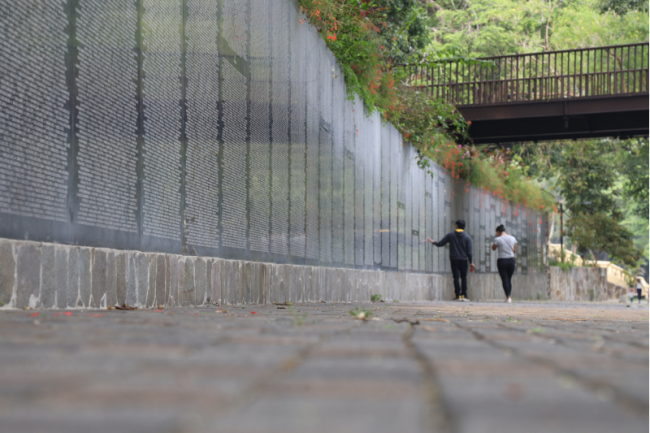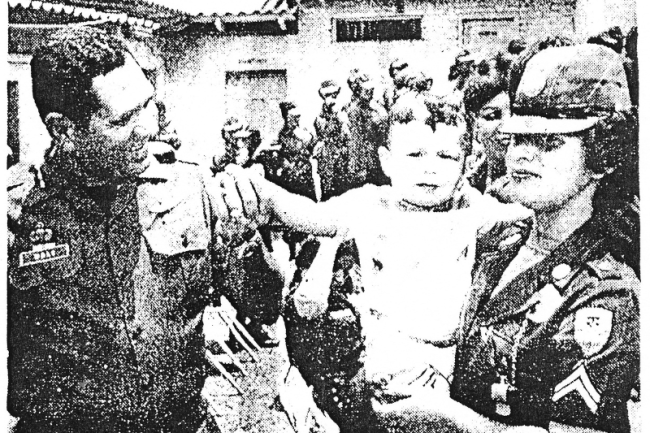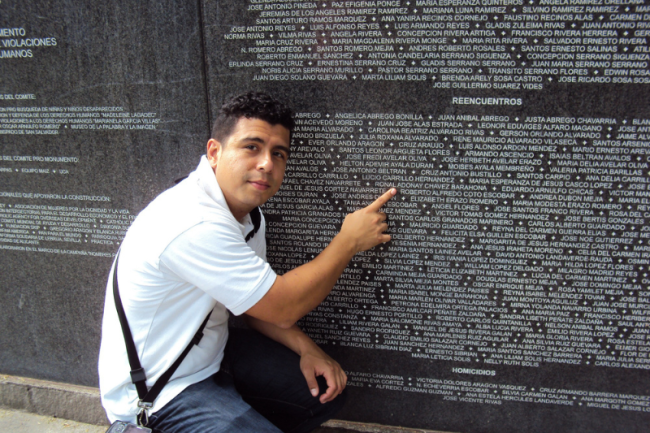
This piece appeared in the Summer 2024 issue of NACLA's quarterly print magazine, the NACLA Report. Subscribe in print today!
It’s a sunny Californian day in late October 2011, and I’m at the headquarters of the Salvadoran American Leadership and Educational Fund, or SALEF, a small community center and nonprofit located in Los Angeles’s Pico-Union district. A friend who has offered to take me sightseeing around the epicenter of the Salvadoran community arranged the visit with SALEF. I’m in LA for a few days to work on my documentary film, Identifying Nelson/Buscando a Roberto, which I had started earlier that year.
On the second floor of SALEF’s modest office, adorned with blue and white flags and pictures of iconic Salvadoran figures like Óscar Romero, we settle into a small meeting room. We are greeted by one of the founders, the executive director, and a handful of community members. My friend explains that I’ve been working on a project that might be of interest to the SALEF community. He motions for me to introduce myself further.
“Hello,” I begin. “My name is Nelson de Witt, and also Roberto Coto. I’m working on a film about El Salvador’s disappeared children.”
“Wait,” the woman next to me immediately blurts out, eyes wide in amazement. “You are one of the disappeared?”
It’s hard to describe the expression on her face—some mixture of surprise, bewilderment, and disbelief, as if she had just seen a spirit return from the dead. Her parents had been revolutionaries in El Salvador’s civil war, she would go on to tell me, and her father had been disappeared.
At that time, calling myself “desaparecido” still felt strange. After all, I hadn’t “disappeared;” I had been adopted and simply grew up away from my family. But something about how she looked at me—or rather, through me—struck me to my core. It would take another decade before I truly understood her reaction and how, in many ways, a ghost was exactly what she saw.
A Miraculous Reunion
In August 1997, my adoptive father received a phone call that would upend everything I thought I knew about myself. I had grown up in the Boston area with a younger brother and had a relatively “normal” American childhood. My adoptive parents worked in academia, we attended church on Sundays, and my brother and I went to sleepover camp during the summers. In fact, we had just started camp when my father got the call.
The man on the other end introduced himself as Dr. Robert Kirschner. He explained that he worked for Physicians for Human Rights and was calling on behalf of a Salvadoran NGO called Asociación Pro-Búsqueda de Niñas y Niños Desaparecidos or Pro-Búsqueda for short. The organization was trying to reunite families separated during the country’s 12-year civil war. They were looking for an infant, the son of revolutionaries, who had gone missing 14 years earlier during a police raid in Honduras. They believed I was that boy, Dr. Kirschner explained. He promised to overnight a dossier detailing their findings and said that if I were willing to take a DNA test, it would confirm this incredible story.

My parents scrutinized that package—containing an investigative report, family photos, and several letters—for the rest of the month. Finally, when my brother and I returned from camp, they broke the news.
I remember looking through the report and seeing a photograph that had appeared in a Honduran newspaper shortly after the raid. In it, I’m being held by a female police officer as a male officer smiles down at me, holding my hand. I got this strange feeling because the boy pictured was very clearly me, but it didn’t feel like me. I had no conscious memory of that moment.
After a positive DNA test, my adoptive family and I flew to Costa Rica to meet my biological family in a tearful reunion. It was the most overwhelming experience of my life. The reunion only lasted a week, but over the following years, I was able to travel throughout Central America and build a life with my biological family. Many people think this is where the story ends, a tragic separation and a miraculous reunion. But for me, the journey was just beginning.
An Unexpected Invitation
In the summer of 2010, I received a Facebook message from someone who had been my camp counselor 30 years prior. His name was John Younger, and he was reaching out to tell me how much he was enjoying reading my blog, Ana’s Miracle, a site I had started with my siblings describing our experiences after the reunion. He also wondered if I’d be interested in working on a documentary film with him.
John had a background in TV and film production, and over the next few months, as we got reacquainted, we began fleshing out the idea. We launched our project on Kickstarter in September and, over two months, raised $15,000 from 170 people. A couple of months later, while we were still trying to figure out how to start the film, I got an invitation from Pro-Búsqueda to attend a historic commemoration for El Salvador’s disappeared children.
At first, I was hesitant to go. The details of my separation were utterly different from the other cases that Pro-Búsqueda had worked on. Many of those children had been taken from rural peasants at gunpoint by the Salvadoran military, whereas my parents had been revolutionaries, and I had been separated from them in Honduras. Still, despite my reluctance, John and I agreed that this was the opportunity we had been looking for.
A Historic Commemoration
I arrived in El Salvador on March 27, 2011, at a time of great hope and optimism. For the first time in the country’s history, a sitting president was going to acknowledge that state-sponsored forced disappearances had taken place during the civil war. Alongside other Salvadorans who had been separated from their families, I was scheduled to attend a private breakfast with the then president, Mauricio Funes.
In the days leading up to the main event, we met government officials and held a press conference at Pro-Búsqueda’s headquarters. Still unsure about my place among the other disappeared, and self-conscious about my ability to speak Spanish, I reluctantly attempted to answer a reporter’s question about the overarching goals of our group. After the press conference, I filmed interviews with several of the desaparecidos, most of whom had grown up in El Salvador, but some of whom had been adopted internationally like me.
Finally, it was time for the big day: President Funes formally apologized for the forced disappearances, the massacre at El Mozote, and other atrocities committed during the war. His efforts were part of a larger reckoning taking place throughout the country during that time. Since the end of the civil war in 1992, no other president had taken strides to confront the country’s difficult past. While his apology was seen as an important first step, many people I spoke with voiced skepticism about whether lasting change would really follow.
Next, I interviewed my family about their experiences during the war and spoke with the coordinator of Pro-Búsqueda. “Pro-Búsqueda is part of your story,” she told me, “and your story is part of Pro-Búsqueda.” While I was still unsure about my place in Salvadoran history, it was powerful to hear her affirmation.
We also traveled to Chalatenango, a department along the border with Honduras that was at the very heart of the conflict, and interviewed a woman named Suyapa Serrano Cruz. In 1982, her two younger sisters were taken during a military operation that survivors remember as the Guinda de Mayo or Flight of May. Even though the Inter-American Court of Human Rights ruled in 2005 that the Salvadoran state had violated the rights of the Serrano Cruz sisters, which led to the creation of a national day to commemorate disappeared children in El Salvador, Suyapa was still waiting to learn the whereabouts of her missing family members. Her moving testimony highlighted the ongoing search for loved ones that many in El Salvador still live with, even to this day.

On my last day, I went to Parque Cuscatlán in San Salvador to visit El Monumento a la Memoria y la Verdad. The monument to truth and memory, fashioned in the style of the Vietnam Memorial in DC, features a 10-foot-high black granite wall that stretches almost the length of a soccer field.
As I walked through this hallowed ground containing tens of thousands of the names of the roughly 75,000 people who died or disappeared during the war, the weight and significance of this history became even more real. About halfway down, I found my mother’s name, and brushing back tears, I stopped to trace my fingers along the engraving.
At the very end of the monument, there was a small half-panel of 200 or so names dedicated to the “reencuentros,” those who had been found, where I discovered my birth name. Much later, when I looked at photographs from that day, I recognized the same look of bewilderment on my face as I saw on the woman at SALEF on that sunny Californian day in LA.
The Work Begins
Upon returning from our trip to El Salvador, John and I got to work. Within a few months, we had an eight-minute clip that concisely explained my separation and reunion. It was thrilling to see my story take shape. The complicated nature of my reunion meant I always had to give a detailed history of my existence. Now, I could show people the clip, and while they may not understand all the nuances, they at least could comprehend the events I had lived through.
Read the rest of this article, freely available online for a limited time.
Nelson de Witt/Roberto Coto was raised in the Boston area and reunited with his family at the age of 16. He is working on an auto-fiction novel and a documentary film about his life as one of El Salvador’s disappeared children. Learn more on his website: nelsonroberto.com.

